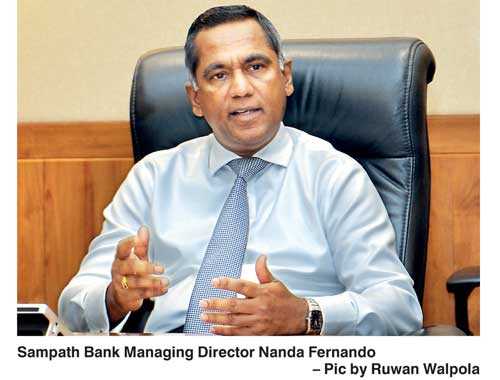Saturday Dec 06, 2025
Saturday Dec 06, 2025
Thursday, 14 June 2018 00:00 - - {{hitsCtrl.values.hits}}
By Shannon Jayawardena
Being the only Lankan firm in the influential MSCI Frontier Market 100 Index, Sampath Bank Managing Director Nanda Fernando this week emphasised the fact that the more FDI, the stronger the economy.
Sri Lanka’s third largest private lender by assets, the bank is the only local company in the index with a weightage of 0.36%.
“It is good governance policies carried out by the bank, foreign lending and the conscious effort to improve the bank that helped us gain recognition as to one of the most profitable banks,” reasoned Fernando.
“We have just completed 31 years in the banking industry as the bank that revolutionised the local banking industry. We have continued this momentum and during the last year we made three strategic changes. One was the transformation of our business model, secondly we went through a process of delegation, and thirdly, we prepared ourselves to suit the future banking needs of the country,” emphasised Fernando.
Fernando went on to say that as a result the bank implemented a project called Paradigm Shift which carried all three components addressing them effectively and as a result the bank saw significant growth in terms of deposit mobilisation, profit growth, advances growth and fee-based income last year.
“We would like to see more and more companies and banks come within this 100 because the more companies in this index, Sri Lanka will be noticed more within the global community. As a result of this, more FDI will flow into the country. When someone wants to invest, they will certainly look into this benchmark index. More FDIs will help us grow and strengthen our economy, so we are very happy as the Sampath team,” he added.
Starting 2018 on a positive note, Sampath Bank achieved a post-tax profit of Rs. 3.3 b for the quarter ended 31 March 2018, an impressive 41.4% growth in comparison to the Profit After Tax (PAT) of Rs. 2.3 b recorded in quarter one in 2017.
Net Interest Income (NII), which is the main source of income representing more than 70% of the bank’s total operating income, recorded an increase of Rs. 2 b (31.0%) during quarter one in 2018 in comparison to quarter one in 2017. Accordingly, the bank recorded NII of Rs. 8.3 b in quarter one in 2018, as against Rs. 6.3 b recorded for the corresponding period in 2017.
The bank’s vision for the future is to be the national bank of Sri Lanka while serving the masses, maximising convenience and delivering products at the lowest cost. It is the combination of the trade ability, liquidity of shares and the capital plan which was implemented during the last two quarters that led to Sampath Bank being recognised in the index.
The bank share’s liquidity has improved compared to the market cap last year with a 33% profit after tax growth. The cost to income ratio is at 39.5% which is a milestone achievement, stated the MD.
Credit growth was about 7.5% at the end of Q1 2018 and the lending demand is said to settle down at approximately 15% by the end of this year.
Sampath Bank’s total asset base grew by 6.5% in quarter one in 2018 to reach Rs. 846 b as of 31 March. The total asset position as of 31 December 2017 stood at Rs. 795 b. Gross loans and receivables from other customers grew by 7.5% during the period and moved up to Rs. 612 b as of 31 March.
Speaking on the bank’s performance in 2016 and 2017 comparatively, Fernando said: “In 2016 we did extremely well, in the sense we had a profit growth of 49% compared to 2015’s profit of Rs. 6.1 b. Similarly in the year 2017 our profits increased by 33% compared to the Rs. 9.1 b in 2016. Both were extremely high when compared to the industry.”
“Year 2017 was a tough year at the start due to certain restrictions such as one of the tracks being re-laid at the airport, the day flights were delayed for nearly two months. Then in March came the floods. Immediately after the floods there was an international dengue warning issued which affected tourist arrivals drastically. Then came the very serious drought, the results of which are still being felt. For coconut production to get back to normal it will take roughly another year. Things take a long time to recover. Customers who took facilities for a short time were unable to pay on the due date, leading them to fall under the non-performing category. As a result they were unable to borrow further from banks. It was really a tough task. However, this we saw a 33% year-on-year increase in profits,” he added.
Further the bank is focused on helping the SME sector of the country to provide banking facilities at a lower cost to all citizens across the country, especially by making banking affordable to the under-banked, stated Fernando.